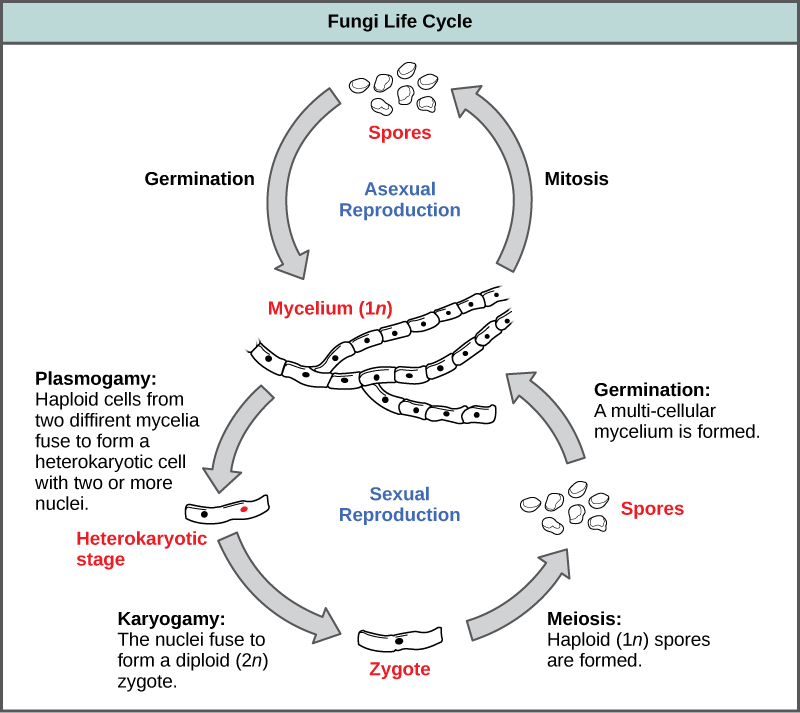Learning Outcomes
- Explain sexual and asexual reproduction in fungi
Fungi reproduce sexually and/or asexually. Perfect fungi reproduce both sexually and asexually, while imperfect fungi reproduce only asexually (by mitosis).
In both sexual and asexual reproduction, fungi produce spores that disperse from the parent organism by either floating on the wind or hitching a ride on an animal. Fungal spores are smaller and lighter than plant seeds. The giant puffball mushroom bursts open and releases trillions of spores. The huge number of spores released increases the likelihood of landing in an environment that will support growth (Figure 1).

Figure 1. The (a) giant puff ball mushroom releases (b) a cloud of spores when it reaches maturity. (credit a: modification of work by Roger Griffith; credit b: modification of work by Pearson Scott Foresman, donated to the Wikimedia Foundation)
Asexual Reproduction

Figure 2. The dark cells in this bright field light micrograph are the pathogenic yeast Histoplasma capsulatum, seen against a backdrop of light blue tissue. (credit: modification of work by Dr. Libero Ajello, CDC; scale-bar data from Matt Russell)
Fungi reproduce asexually by fragmentation, budding, or producing spores. Fragments of hyphae can grow new colonies. Somatic cells in yeast form buds. During budding (a type of cytokinesis), a bulge forms on the side of the cell, the nucleus divides mitotically, and the bud ultimately detaches itself from the mother cell. Histoplasma (Figure 2) primarily infects lungs but can spread to other tissues, causing histoplasmosis, a potentially fatal disease.
The most common mode of asexual reproduction is through the formation of asexual spores, which are produced by one parent only (through mitosis) and are genetically identical to that parent (Figure 3). Spores allow fungi to expand their distribution and colonize new environments. They may be released from the parent thallus either outside or within a special reproductive sac called a sporangium.

Figure 3. Fungi may have both asexual and sexual stages of reproduction.

Figure 4. This bright field light micrograph shows the release of spores from a sporangium at the end of a hypha called a sporangiophore. The organism is a Mucor sp. fungus, a mold often found indoors. (credit: modification of work by Dr. Lucille Georg, CDC; scale-bar data from Matt Russell)
There are many types of asexual spores. Conidiospores are unicellular or multicellular spores that are released directly from the tip or side of the hypha. Other asexual spores originate in the fragmentation of a hypha to form single cells that are released as spores; some of these have a thick wall surrounding the fragment. Yet others bud off the vegetative parent cell. Sporangiospores are produced in a sporangium (Figure 4).
Sexual Reproduction
Sexual reproduction introduces genetic variation into a population of fungi. In fungi, sexual reproduction often occurs in response to adverse environmental conditions. During sexual reproduction, two mating types are produced. When both mating types are present in the same mycelium, it is called homothallic, or self-fertile. Heterothallic mycelia require two different, but compatible, mycelia to reproduce sexually.
Although there are many variations in fungal sexual reproduction, all include the following three stages (Figure 3). First, during plasmogamy (literally, “marriage or union of cytoplasm”), two haploid cells fuse, leading to a dikaryotic stage where two haploid nuclei coexist in a single cell. During karyogamy (“nuclear marriage”), the haploid nuclei fuse to form a diploid zygote nucleus. Finally, meiosis takes place in the gametangia (singular, gametangium) organs, in which gametes of different mating types are generated. At this stage, spores are disseminated into the environment.
Fungivores
Animal dispersal is important for some fungi because an animal may carry spores considerable distances from the source. Fungal spores are rarely completely degraded in the gastrointestinal tract of an animal, and many are able to germinate when they are passed in the feces. Some dung fungi actually require passage through the digestive system of herbivores to complete their lifecycle. The black truffle—a prized gourmet delicacy—is the fruiting body of an underground mushroom. Almost all truffles are ectomycorrhizal, and are usually found in close association with trees. Animals eat truffles and disperse the spores. In Italy and France, truffle hunters use female pigs to sniff out truffles. Female pigs are attracted to truffles because the fungus releases a volatile compound closely related to a pheromone produced by male pigs.
Try It
